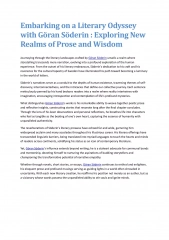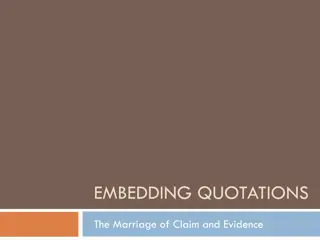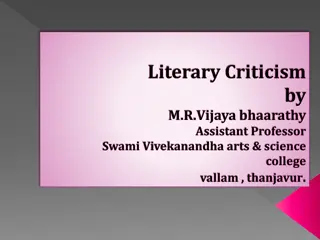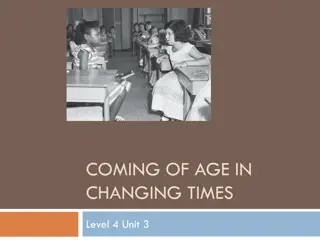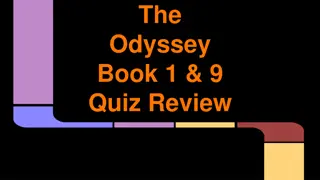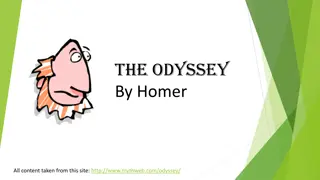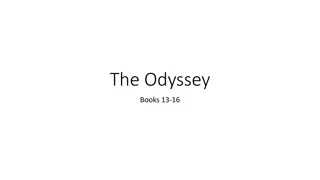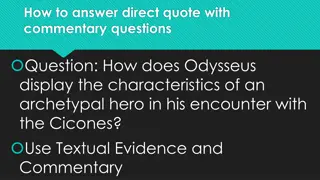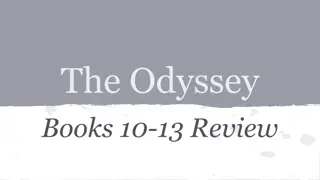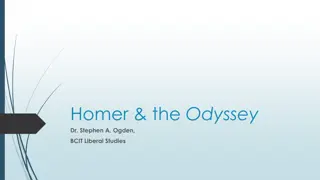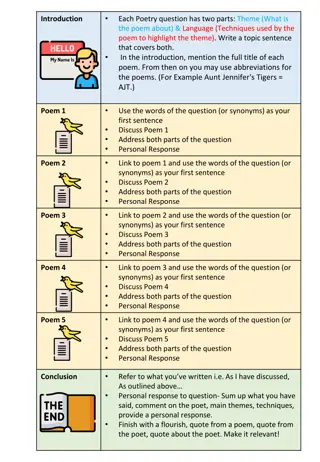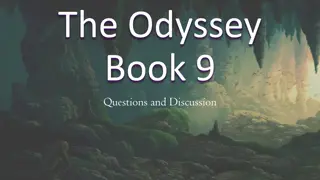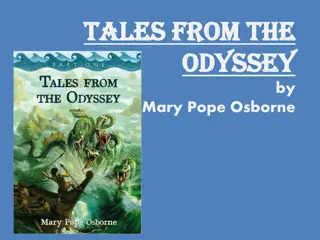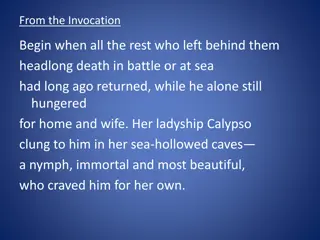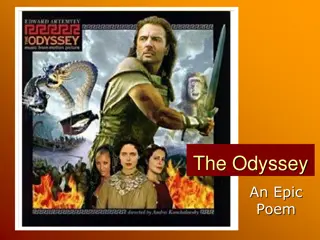Journey Through "The Odyssey": Themes, Author, and Literary Analysis
Explore the epic journey of Odysseus in "The Odyssey," delving into themes of pride, love, courage, and more. Uncover the background of the author, Homer, and the ancient Greek world. Identify key literary vocabulary and skills essential for the study of literature. Discover how the text is organized, from Odysseus' wanderings to his homecoming, and grasp important literary definitions such as plot, setting, and climax. Embark on an intellectual odyssey of self-discovery through this timeless classic.
Download Presentation

Please find below an Image/Link to download the presentation.
The content on the website is provided AS IS for your information and personal use only. It may not be sold, licensed, or shared on other websites without obtaining consent from the author. Download presentation by click this link. If you encounter any issues during the download, it is possible that the publisher has removed the file from their server.
E N D
Presentation Transcript
The Epic THE ODYSSEY
THE ODYSSEY OBJECTIVES WHAT IS THE FOCUS FOR TODAY? Introduce themes in The Odyssey Provide background information on the author, Homer, and ancient Greece. Identify important literary vocabulary Identify skills important to the study of literature
WHAT IS AN ODYSSEY? Od*ys*sey n.pl. od*ys*seys An extended adventure or voyage. An intellectual or spiritual quest of the mind; an odyssey of self-discovery. Odysseus Epic Journey= The Odyssey
MEET THE AUTHOR: HOMER ONE OF THE EARLIEST KNOWN POETS Homer was a Greek Poet in the 7thCentury B.C. who wrote epics like The IIiad and The Odyssey. He was said to have been blind. First person to write down oral traditions.
THEMES IN THE ODYSSEY Pride is both a strength and a weakness Love is eternal Courage The fate of a nation Beauty and Temptation Loyalty Life and Death
HOW IS THE TEXT ORGANIZED? Part One : - The Wanderings of Odysseus Odysseus leads a crew of soldiers on a long oversea Journey, replete with danger, trying to get home to his wife and son in Ithaca. We will complete a brochure project for this journey. Worth 200 points
HOW THE TEXT IS ORGANIZED Part Two - The Homecoming Odysseus makes it back home and has to rebuild his domestic, family life.
DEFINITIONS YOU SHOULD ALREADY KNOW BY NOW Plot: The series of events in a story, NOT WHAT IT S ABOUT. Setting: When and where a story takes place. Exposition: character, setting, conflict is introduced. Rising Action: conflict deepens Climax: highest point of suspense Falling Action: conflict comes to an end Resolution: the character expresses gain of knowledge and betterment of character.
CHARACTERISTICS OF AN EPIC In literature, an epic recounts the adventures of an epic hero An epic hero epic hero is a larger-than-life figure who undertakes great journeys and performs deeds requiring remarkable strength and cunning. epic is a long narrative poem. It epic hero.
EPIC AT A GLANCE Epic Hero Epic Hero Possess super human strength, craftiness, and confidence Is helped and harmed by interfering gods Embodies ideals and values that a culture considers admirable Emerges victorious from perilous situations
EPIC AT A GLANCE Epic Plot Epic Plot Involves a long journey, full of complications, such as: Strange creatures Divine intervention Large-scale events Treacherous weather
EPIC AT A GLANCE Epic Setting Epic Setting Includes fantastic or exotic lands Involves more than one nation
ARCHETYPES All epics include archetypes- characters, situations, and images that are recognizable in many times and cultures: Sea monster Wicked temptress Buried treasure Suitors contest Epic hero Loyal servant
EPIC THEMES Reflect such universal concerns as Courage The fate of a nation Beauty Loyalty Life and death
THE LANGUAGE OF HOMER A simile is a comparison between two unlike things, using the word like or as. Homer often develops a simile at great length, so that it goes on for several liens. This is known as an epic simile epic simile. Example: His rage held hard in leash, submitted to his mind, while he himself rocked, rolling from side to side, as a cook he himself rocked, rolling from side to side, as a cook turns a sausage, big with blood turns a sausage, big with blood And fat, at a scorching blaze, without a pause, And fat, at a scorching blaze, without a pause, To broil it quick: so he rolled left and right To broil it quick: so he rolled left and right
THE LANGUAGE OF HOMER An epithet epithet is a brief descriptive phrase used to characterize a particular person or thing. When a poet needed to fill out a line, he d add an epithet with the right meter and number of syllables. Odysseus is known by various epithets including son of Laertes son of Laertes and raider of cities epithets, raider of cities
THE LANGUAGE OF HOMER An allusion allusion is a reference to a famous person, place, or event. To help his audience picture what he described, a poet might have made an allusion to something they already knew. For instance, when Odysseus son first sees the palace of Menelaus, he says, This is the way the court of Zeus must be. Every Greek would have understood this allusion to the ruler of the gods.
THE LANGUAGE OF HOMER Allusion is not to be confused with illusion. Illusion: something that deceives by using false or misleading impression of reality.
READING THE EPIC Narrative: Who is telling the story at any given point? Consider how the different narrators deepen your understanding. Visualize the action and the settings by using details in the text. Track the events and conflicts and try to predict the outcomes.
READING THE EPIC Poetry: Try reading the lines aloud, as the epic was originally performed. Read the lines for their sense, just as you would read prose. Follow the punctuation, and remember that the end of a line does not always mean the end of a thought. Listen for sound devices such as alliteration, assonance, consonance, and rhyme and notice how they reinforce meaning. Consider how the imagery and figurative language- especially the epic similes- help you understand characters and events.
READING THE EPIC A reflection of its time: Pay attention to the character traits of Odysseus, the epic hero, by looking closely at how he behaves and how he is described. What do these traits tell you (the reader) about the values of the time? Remember that in Homer s time most Greeks believed that the gods took an active interest in human affairs and themselves behaved much like humans. How are these religious beliefs apparent in the epic?


